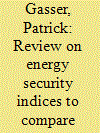|
|
|
Sort Order |
|
|
|
Items / Page
|
|
|
|
|
|
|
| Srl | Item |
| 1 |
ID:
111414


|
|
|
|
|
| Publication |
2012.
|
| Summary/Abstract |
Quantifying wind potential is a pivotal initial step in developing and articulating a state's policies and strategies for offshore wind industry development. This is particularly important in the Great Lakes States where lessons from other offshore environments are not directly applicable. This paper presents the framework developed for conducting a preliminary assessment of offshore wind potential. Information on lake bathymetry and wind resources were combined in simulating alternative scenarios of technically feasible turbine construction depths and distance concerns by stakeholders. These yielded estimates of developable offshore wind areas and potential power generation. While concerns about the visibility of turbines from shore reduce the power that can be generated, engineering solutions that increase the depths at which turbines can be sited increase such potential power output. This paper discusses the costs associated with technical limitations on depth and the social costs related to public sentiments about distance from the shoreline, as well as the possible tradeoffs. The results point to a very large untapped energy resource in the Michigan's Great Lakes, large enough to prompt policy action from the state government.
|
|
|
|
|
|
|
|
|
|
|
|
|
|
|
|
| 2 |
ID:
103486


|
|
|
|
|
| Publication |
2011.
|
| Summary/Abstract |
Alternative fuels for the transport sector are gaining growing attention as a means against fossil fuel dependence and towards greener forms of energy. At the same time, however, they are surrounded with doubts concerning sustainability of their production. This work presents the basic framework for a decision support tool to evaluate biofuel production pathways, with the purpose of providing the decision maker with a structured methodology that will lead him to the final decision. The tool integrates the most important aspects along the entire value chain (i.e. from biomass production to biofuel end-use), namely the technical, economic, environmental and social aspect. The tool consists of a computational part, which can be combined with the personal preferences of the user. The analysis provides a score for the respective pathway that can be used to rank different options and select among them the optimal solution. The functionality of the tool has been tested for the case of biodiesel from rapeseed in Germany.
|
|
|
|
|
|
|
|
|
|
|
|
|
|
|
|
| 3 |
ID:
166570


|
|
|
|
|
| Summary/Abstract |
Modern electricity markets are characterized by an increasing share of renewable electricity generation. This growth in the share of renewables yields a highly intermittent generation structure. To efficiently integrate renewable electricity generation into our energy system, flexibility options ranging from storage facilities to demand-side management will play a major role in the low-carbon energy transformation. Keeping up with the growing demand for flexibility, energy law must reduce current investment obstacles for flexibility options and establish a climate for future investments with sufficient incentives for private investors. By taking up perspectives from different disciplines, this paper summarizes current investment barriers, presents an overview of the existing legal energy investment framework of the EU and Germany, and elaborates on challenges of the presented legislation. As we argue, a well-designed energy market legislation will be one of the keys to a successful energy transition. However, policy makers will have to (i) lower investment uncertainty for private investors, (ii) avoid a distortion of energy investment law towards specific flexibility options and technologies, and (iii) reduce the complexity of the current legislation.
|
|
|
|
|
|
|
|
|
|
|
|
|
|
|
|
| 4 |
ID:
127898


|
|
|
|
|
| Publication |
2014.
|
| Summary/Abstract |
This paper examined the potentialities of Life Cycle Assessment (LCA) as instrument for policy-support. To this respect, the adoption of an initiative within the Madrid Air Quality Plan (AQP) 2011-2015 regarding the substitution of diesel taxis with hybrid, natural gas and LPG alternatives was studied. Four different scenarios were elaborated, a business-as-usual scenario (BAU), the scenario of the AQP, and two extreme-situation scenarios: all-diesel (ADI) and all-ecologic (AEC). Impacts were characterized according to the ILCD methodology, focusing especially on climate change (CC) and photochemical ozone formation (PO). SimaPro 7.3 was used as analysis and inventory-construction tool. The results indicate that the shift to ecologic alternatives reduced impacts, especially those related to CC and PO. For the complete life cycle, reductions of 13% (CC) and 25% (PO) were observed for AQP against BAU (CC:1365 GgCO2, PO:13336 MgNMVOC). Deeper reductions were observed for AEC (CC:34%, PO:59%), while ADI produced slight increases in impacts if against BAU. The analysis of the use-phase revealed that the central and highest speed zones of the city benefit from the adoption of AQP. This is especially evident in zone 7, with reductions of 16% in CC and 31% in PO respectively against BAU (CCzone1:3443 kgCO2/veh·km, POzone7:11.1 kgNMVOC/veh·km).
|
|
|
|
|
|
|
|
|
|
|
|
|
|
|
|
| 5 |
ID:
113495


|
|
|
|
|
| Publication |
2012.
|
| Summary/Abstract |
A significant number of African States have adapted energy access targets. In evaluating progress towards these goals, measuring and monitoring energy access becomes relevant. This paper reviews energy access indicators and identifies their utility and challenges in their application. By focusing on Africa, a broader framework for energy access measurement and monitoring is discussed, along with implementation barriers and potential solutions. To demonstrate the utility of energy access decision-support tool in Africa, a scenario analysis in five regional energy pools is conducted using the Energy Spending Model tool. Institutionalizing monitoring and decision-support tools can provide valuable feedback to policymakers aiming to design and implement effective energy access programs serving a growing population in Africa.
|
|
|
|
|
|
|
|
|
|
|
|
|
|
|
|
| 6 |
ID:
176698


|
|
|
|
|
| Summary/Abstract |
The use of energy security indices has been increasing recently, as indicator-based approaches are particularly suitable to model multiple dimensions and compare countries. Moreover, indices represent effective communication tools for policymakers. This paper analyzes 63 indices quantifying the energy security performance of countries. In particular, their scope, geographical coverage, number of countries analyzed, time frame covered, number of indicators considered, data treatment approach, multivariate analysis, normalization, weighting and aggregation of the indicators, and the assessment of uncertainty, sensitivity and robustness are reviewed. Results show that there is a considerable lack of transparency, especially about the selection of the indicator set, normalization method, indicator weighting scheme and aggregation function. Furthermore, the index construction steps of data treatment and multivariate analysis are either not performed or under-reported. Finally, only few studies provide an uncertainty, sensitivity or robustness analysis, even though such an analysis has the potential to greatly improve the confidence into the results. Based on the findings of this paper, research gaps are identified and recommendations for future research provided. Even though the present analysis was conducted on energy security, the findings can be applied to indices in any field in order to support well-informed decision-making.
|
|
|
|
|
|
|
|
|
|
|
|
|
|
|
|
|
|
|
|
|